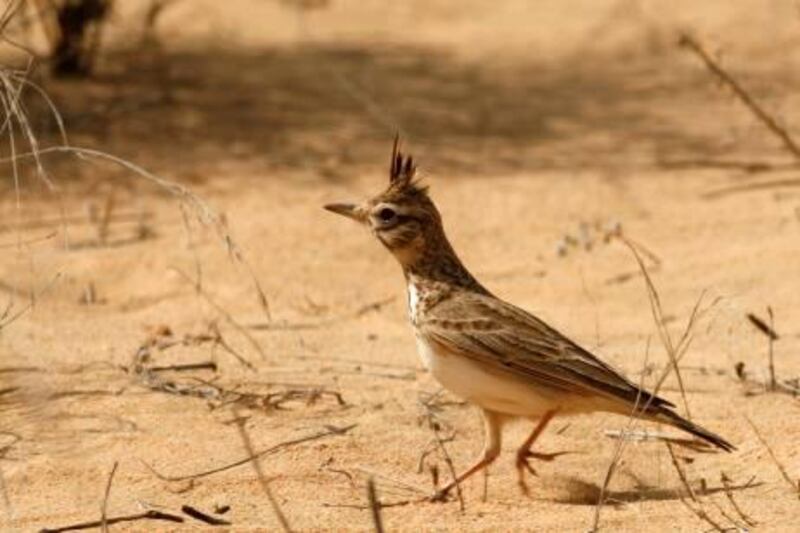DUBAI // In the desert 70 kilometres outside the city, Dr Reza Khan is making his usual early morning rounds when he spots one of the rarest indigenous bird species in the UAE - the Desert Eagle Owl.
Dr Khan, the wildlife and zoo specialist for the Public Parks and Horticulture Department at Dubai Municipality, has been tracking owls and other animals for 23 years.
He climbs into his Nissan Patrol before dawn each day to track and monitor wildlife in reserves and parks across the emirate, and photograph them as a record.
At the Ras Al Khor Wildlife Sanctuary, he and his colleagues undertake a weekly count of birds to check numbers, new trends and habits.
Of the 450 bird species in and around the city, about 80 per cent are migratory. The influx of new species, mainly from Central Asia, began in the early 1990s and the trend has threatened some indigenous species.
Migration was partly due to government investment in feeding programmes, the development of new green areas and the protection of natural habitats like the mangroves at Ras Al Khor Wildlife Sanctuary.
Migratory species like the Greater Flamingo are said to play a pivotal role in the biodiversity of the city. "Some migratory birds enrich the environment," Dr Khan says. "Due to a growth in man-made greenery, the numbers of insects increased and so did the number of migratory birds that eat the insects."
One of the most notable increases has been in the number of flamingos, which rose from 1,220 a decade ago to more than 3,500 today.
In his years on the job, Dr Khan has monitored the arrival of several species of bird, plant and animal. But the arrival of new species becomes a problem when they threaten the existence of indigenous wildlife, he explains.
Consider the number of birds indigenous to Dubai, he says: their flocks are decreasing, and some species face extinction. The indigenous Graceful Warbler, for example, has decreased by 20 per cent in the past few years, while the Houbara Bustard is almost extinct.
Another reason the number of indigenous birds has decreased is habitat destruction, says Tommy Pederson, an Emirates Airline pilot who runs the birdwatching website, www.uaebirding.com.
"Ten years ago you would see pure desert, and now many areas have been criss-crossed by roads and dune buggies, which destroys a lot of breeding potential," he says.
An avid bird watcher for 35 years, Mr Pederson says projects like the Dubai Desert Conservation Reserve create a place for breeding. "You can find the Desert Eagle Owl there, and other species, like Chestnut-bellied Sandgrouse."
But the main reason for the decrease remains the introduction of exotic birds. Dr Khan says people have brought in birds like crows and mynas to breed and sell.
"During the 1990s, this was a very destructive trend," he says. The most destructive bird introduced was the Indian House Crow, first spotted in Abu Dhabi in 1991. "Now, there are thousands of them that destroy baby birds and eggs, and carry diseases," Dr Khan says.
Mr Pederson agrees: "Introduced species like the Indian House Crow, Myna and Parakeet have a hugely negative affect."
Back in the desert, as Dr Khan approaches the nest of the Desert Eagle Owl, the bird takes flight. Only 20 pairs of the owl are thought to remain in Dubai.
Today, there is good news: disturbed from her perch, the owl has revealed a nest of four eggs.
"She will come back in about half an hour," Dr Khan says. And he will back next week, hoping this brood hatches safely.
Plant life at the root of other species
Birds are largely drawn to an area by new plant species, which can be both a boon and a burden to the ecosystem in itself. “Plants are the basis of all organisms,” said Dr Taoufik Saleh Ksiksi, associate professor in the biology department of UAE University’s faculty of science. “The biodiversity of the plant is a direct indication of the biodiversity of other species, including birds.” There are at least 600 plant types in the city, however, both Dr Ksiksi and Dr Khan favour indigenous plants. “We should never introduce exotic plants as a first option – only when there is no alternative. Exotic plants use more water and their environment is different,” said Dr Ksiksi. “Many native species are also more efficient in sequestering soil carbon, which minimises carbon dioxide emissions.” To Dr Khan, exotic plants are poor replacement for what is already available here. “There are so many beautiful local plants and trees, like the Cedar and Til, so why always bring from other places?” he said. The use of exotic plants can also prove costly. “Lots of farms have been abandoned here due to the encroachment of newly-introduced species that harm indigenous plants,” said Dr Ksiksi. These includes the species known as ghuwaif – or prosopis juliflora – which is particularly harmful because it produces chemicals that are deadly to other species, or in other words, it is allelopathic. Some countries spend millions of dollars getting rid of exotic allelopathic species. “Prevention is more efficient – environmentally, financially and socially – than the eradication of unwanted species,” said Dr Ksiksi. “There are many laws and regulations in place regarding exotic plants brought to the country but some still manage to get by.”





